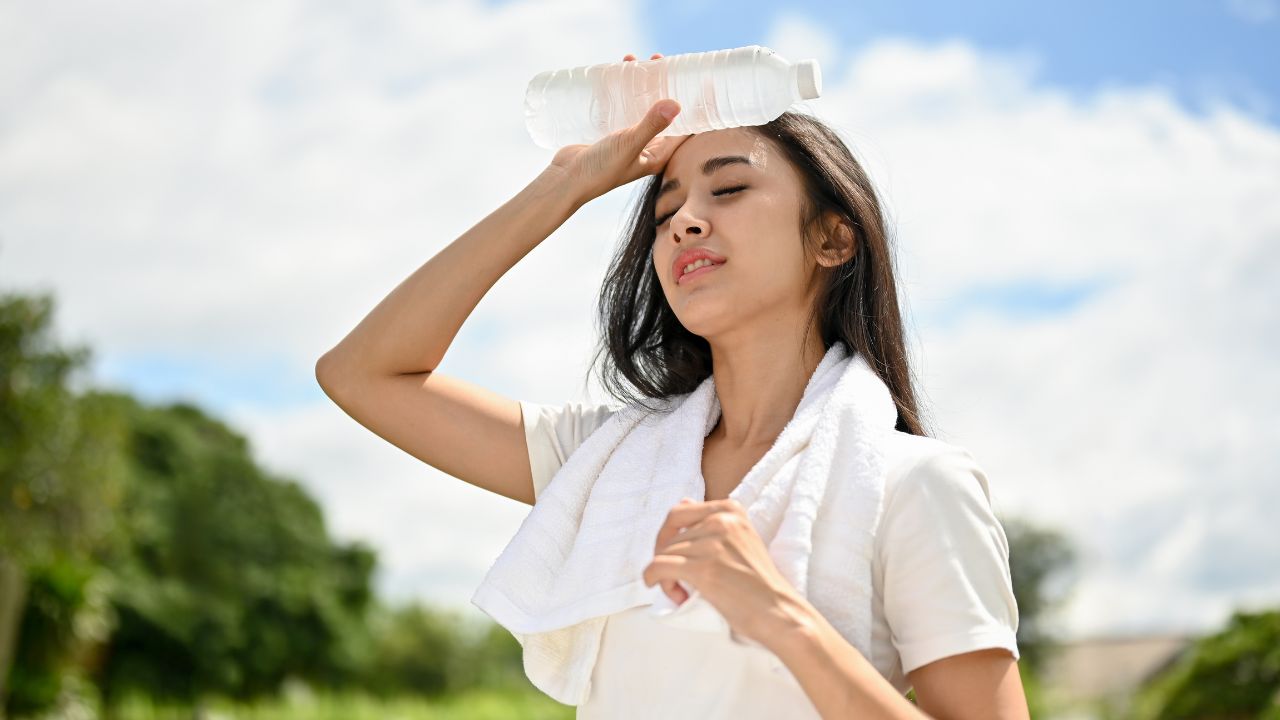Engaging in regular running activities can greatly contribute to an overall improvement in one's fitness levels, heart health, and emotional well-being.
The challenges of running in hot weather include the potential for overheating, dehydration, and heat exhaustion. Staying cool during your run is essential for maintaining your performance, ensuring safety, and making your running experience more enjoyable.
Whether you’re a seasoned runner or a beginner, understanding how to stay cool while running can make all the difference, especially during the sweltering summer months. Wearing breathable gear like a Merino wool t-shirt can help regulate your body temperature and wick away moisture. This article will provide you with comprehensive tips and tricks to keep cool, hydrated, and comfortable during your runs so you can enjoy your workout without compromising your health.
Preparation is Key
1. Importance of Acclimatization
Before you hit the pavement in the heat, it’s crucial to allow your body to acclimatize to the higher temperatures. Acclimatization is how your body gradually adjusts to the heat, improving your ability to sweat and maintain a lower core temperature during exercise.
Start by running in the heat for short periods, gradually increasing your exposure over one to two weeks. This will help your body become more efficient at cooling itself, reducing the risk of heat-related issues.
Read More: Is Merino Wool Good for Running?
2. Gradual Adaptation to Heat
When adapting to running in hot weather, it’s important to listen to your body. Begin with shorter runs during cooler parts of the day and progressively increase your duration and intensity as your body adjusts.

This gradual adaptation allows your cardiovascular system to better handle the stress of running in heat, enhancing your overall endurance. You may also notice an improvement in your sweat rate and a decrease in your perceived exertion, making your runs more manageable even as the temperatures rise.
3. Best Time of Day to Run in the Heat
Timing is everything when it comes to running in high temperatures. Early mornings and late evenings are the best times to run during hot weather, as temperatures are generally lower and the sun is less intense.

Running during these cooler periods minimizes the risk of heat exhaustion and sunburn. If your schedule forces you to run during the hottest part of the day, try to find shaded routes and avoid running on reflective surfaces like asphalt, which can intensify the heat.
What to Wear for Running

1. Lightweight, Breathable Clothing
Wearing the right gear is essential to staying cool while running in the heat. Opt for lightweight, breathable clothing that allows for maximum airflow and helps wick moisture away from your skin.
Loose-fitting clothes made from technical fabrics like polyester blends or natural fibers like Merino wool are excellent choices. These materials are designed to pull sweat away from your body, allowing it to evaporate more easily, which helps keep your body temperature regulated. Check out Merino Wool Lightweight t Shirt.
2. The Importance of Moisture-Wicking Fabrics
Moisture-wicking fabrics are a runner’s best friend in hot weather. These materials draw sweat away from your skin to the fabric’s outer surface, where it can evaporate more quickly. This process not only keeps you dry but also helps your body cool down more efficiently.

Merino wool, in particular, is an outstanding option for hot-weather running. It’s a natural, breathable fabric with excellent moisture-wicking properties. Additionally, it’s odor-resistant, making it ideal for long runs where you might sweat a lot. For more options, check out Merino Protect, which offers a range of high-quality Merino wool clothing designed to keep you cool and comfortable during your runs.
3. The Benefits of Wearing a Hat and Sunglasses
Protecting yourself from the sun’s harsh rays is another important factor in staying cool. A lightweight, breathable hat with a wide brim can shield your face and neck from direct sunlight, reducing the risk of sunburn and overheating.
Choose a hat made from moisture-wicking material to keep sweat from dripping into your eyes. Sunglasses with UV protection are also essential for shielding your eyes from the sun, preventing glare, and reducing strain, allowing you to focus better on your run.
Hydration and Nutrition
1. The Importance of Proper Hydration
Hydration is perhaps the most critical aspect of running in the heat. Your body loses a significant amount of fluid through sweat when you run, so it’s essential to replace that fluid to avoid dehydration. Ensure proper hydration before your run by consuming water throughout the day. During your run, aim to drink small amounts of water every 15-20 minutes, depending on the temperature and your sweat rate. Post-run, continue hydrating to replenish lost fluids and support recovery.

2. Electrolyte-Rich Drinks and Snacks
While water is crucial, it’s not enough on its own. When you sweat, you also lose electrolytes—minerals like sodium, potassium, and magnesium—that are vital for muscle function and maintaining fluid balance in your body. Consuming electrolyte-rich drinks or snacks can help replenish these essential nutrients and prevent cramping and fatigue.
Sports drinks, coconut water, or electrolyte tablets mixed with water are all good options. Additionally, snacks like bananas, nuts, or energy gels can provide a quick source of electrolytes and energy during your run.
3. Timing Your Hydration
It’s important to find the right balance with hydration—too little, and you risk dehydration; too much, and you could experience discomfort or even hyponatremia (a dangerous drop in sodium levels). Pay attention to your body’s signals, such as thirst, dry mouth, or dark urine, which indicate dehydration. Conversely, avoid overhydrating by drinking small, consistent sips rather than large amounts of water at once.
Running Techniques
1. The Importance of Pacing and Taking Breaks
Running in the heat requires a different approach than running in cooler conditions. Pacing yourself is key to preventing overheating and exhaustion. Start your run at a slower pace than usual to allow your body to adjust to the heat. If you feel yourself getting too hot or tired, don’t hesitate to slow down or take a walking break.

Incorporating walk breaks into your run not only helps to cool you down but also allows your body to recover, making it easier to complete your workout without overexerting yourself.
2. Utilizing Walk Breaks to Cool Down
Walk breaks are an effective way to manage your body temperature during a hot run. By slowing down and walking, you reduce the intensity of your workout, which helps lower your heart rate and allows your body to cool down. Use this time to hydrate and assess how you’re feeling. Walking in shaded areas or near a breeze can further enhance the cooling effect, making it easier to resume running once you’ve recovered.
3. The Benefits of Running in Shaded Areas
When you have the choice, pick paths with plenty of shade. Running in shaded areas can significantly reduce your exposure to direct sunlight, helping to keep your body temperature in check. Trees, buildings, and even tall bushes can provide much-needed relief from the sun.
Additionally, running in natural areas with plenty of greenery can have a cooling effect, as plants release moisture into the air through a process called transpiration, creating a more comfortable microclimate for your run.
Additional Tips
1. The Benefits of Using Cooling Towels and Cold Compresses
Cooling towels and cold compresses are excellent tools for keeping your body temperature down during and after your run. These towels are designed to retain cold water, which can be placed around your neck, wrists, or forehead to provide immediate relief from the heat.

Some cooling towels are even designed to stay cold for extended periods, making them a perfect companion for long runs in hot weather. Cold compresses can also be used post-run to cool down quickly and reduce inflammation in muscles and joints.
2. Listening to Your Body and Taking Rest Days
One of the most important tips for running in the heat is to listen to your body. Heat can exacerbate the physical strain of running, so it’s crucial to pay attention to signs of heat exhaustion, such as dizziness, excessive sweating, nausea, or confusion.

If you experience any of these symptoms, stop running immediately and find a cool place to rest and hydrate. It’s also essential to incorporate rest days into your routine, especially during periods of intense heat, to allow your body to recover fully and avoid overtraining.
Conclusion
Running in hot weather can be challenging, but with the right preparation, gear, and strategies, you can stay cool, comfortable, and safe. You can enjoy your runs even in the hottest conditions by acclimating to the heat, wearing appropriate clothing, staying hydrated, and listening to your body.
Remember, the key to a successful hot-weather run is to balance effort with caution, making sure to prioritize your health and well-being over performance.
For the best breathable and moisture-wicking clothing to keep you cool during your runs, visit Merino Protect. Embrace the summer heat and continue your running journey with confidence, knowing you’re equipped with the knowledge and tools to stay cool and comfortable on the go.
FAQs About How to Stay Cool While Running: Tips and Tricks for a Comfortable Run
1. What is the Best Time of Day to Run to Stay Cool?
Early morning or late evening, when temperatures are generally lower, is the best time to run to stay cool.
2. How Can Clothing Choices Affect Your Comfort While Running?
Wearing lightweight, moisture-wicking fabrics can help keep you cool and dry by allowing sweat to evaporate more easily.
3. What Role Does Hydration Play in Staying Cool During a Run?
Staying hydrated is crucial. Hydrating with water before, during, and after your run is a key factor in maintaining a balanced body temperature and avoiding the risks of overheating. Proper hydration helps to cool the body and keep your performance at its peak during physical activity.
4. Are There Any Specific Types of Hats or Accessories That Can Help Keep You Cool?
A breathable, moisture-wicking hat or visor can protect you from the sun and help keep sweat out of your eyes, enhancing comfort.
5. How Can Running in Shaded Areas Help?
Running in shaded areas can significantly reduce your exposure to direct sunlight, keeping your body temperature lower.
6. What Are Some Tips for Adjusting Your Pace to Stay Cool?
Slowing down your pace, especially during hotter parts of the day, can help prevent overheating and make your run more comfortable.
7. What Should You Do if You Start Feeling Overheated During a Run?
If you feel overheated, it's important to stop running, find shade, drink water, and cool down with wet cloths or cold packs.
8. What Are Some Signs You Should Stop Running Due to Heat?
Signs such as dizziness, nausea, excessive sweating, or confusion indicate that you should stop running immediately and seek a cool place to rest and hydrate.









Hinterlassen Sie einen Kommentar